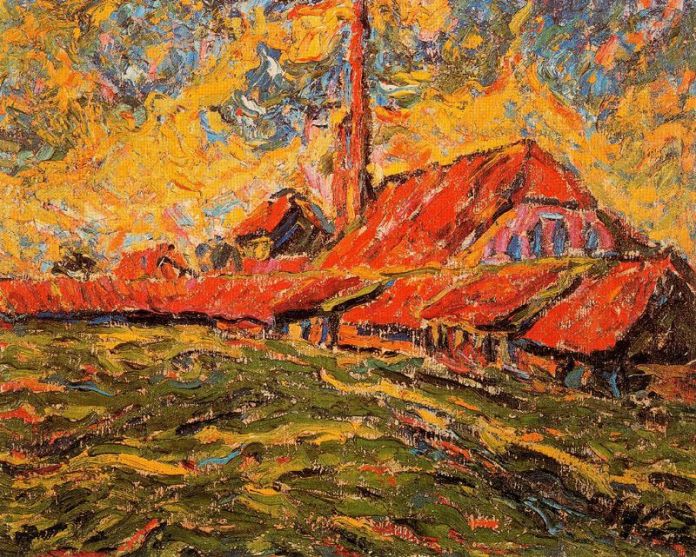Kweiseye is an art criticism blog written by Tom Kwei. If you enjoy this article, browse the archive here for more than 60 other critiques of both artists and exhibitions. Any questions/queries/use: tomkweipoet@gmail.com.
Heckel was one of the original founders of Die Brücke (1905 – 1913), an influential German school of painting that aimed to connect their regional artistic past, such as that seen within the tradition of Neo Romantic painting, with the contemporary Expressionist present – the name translates literally as ‘The Bridge’.
As a result of this interesting style pairing there is much of the inner experience within the work. Immediacy is heightened through an abandonment for the most part of proportion & perspective, with colour, much like through the Fauvists before them, becoming a means of emotion in of itself entirely. Yet whereas the Fauves were filled with exuberance and joy (such as the earlier explored, Raoul Dufy), Heckel’s work is fraught and complex in emotion, developing its direct impact from its precise sense of detail rather than its detail being absorbed by sheer sensation.
‘Crystal Day’ – 1913
In its own scorched & jagged way there is much beauty within ‘Crystal Day’. Though said attraction doesn’t stem from the faceless voluptuousness cut off at the ankles in the water, or indeed the general quietness of the scene, but rather it is through the use of the angular that Heckel employs throughout.
The image really seems to clamp down around the viewer. The shoreline at the lefthand side extending out from the gently evoked greenery to the water itself and forming a hinge of sorts which leans forward reflecting the abstract clouds to the jagged icicles below. As a result of this inward cast horizon everything is foreshortened. The woman upfront bathing appears to perfectly embody this mildly contorted aesthetic as her oddly positioned arms fit snugly within the cliffside reflection of the water. The worn rocks too are nearby neatly nestled but never touching the cloud patterns on the lake. Heckel’s effect here then is one of the crystalline, a sense of direct statis in which all parts carefully lattice.
The artist has our eye both transfixed into this stillness as well as onto the slightly abstruse cloud patterns that shout from the inverted back edge of the image. These designs seeming less to strive towards any technique, and more to act as fodder in which Heckel can experiment with ideas of reflection and distortion. Everything comes in a furious brush that at times give the scene a slightly uncomfortable edge. As with the majority of Expressionist influenced work of the period, there is an erratic quality burrowed beneath the vision so that the setting and figure are common, but the feelings are not.
‘La fábrica de ladrillos – 1907

This painting positively hums with colour. The technique festive and involving, both perfectly logical within the context of Die Brücke’s goals as well as objectively intriguing with its muddy swathed technique. There is no message here, no familiar signal to something else through a compositional language. Rather it is the sense of immediacy that is king.
It does perhaps seem at first that the building stretching throughout the painting is maybe on fire. The lunges of goldenrod lapping above the structure in greedy uproars. But when the bubbling ground and shifting eaves are observed closer it becomes clear that this is merely the mode the German has chosen.
And whilst the ground is remarkable for its strange spills of colour with small tufts of flowers emerging from the undergrowth for a spell before being swallowed by the marshy greens – the sky crafts a sense of actual communication. With the diaphanous sky blue interacting with the blazing sky as if they were two dyes in water. The section around the steep column at the middle of the church is particularly fantastic. Its delicacy of blending a hypnotic construction viewed unclose. Everything seems calculated here by Heckel, the pleasure perhaps more in the ability to construct what appears to be frantic, rather than something that is.
Enjoy reading that? Click HERE to see a list of all the art analyses on Kweiseye to date.
To keep up with the blog and all the art I write about, follow me right here on this blog or here @tomkweipoet

